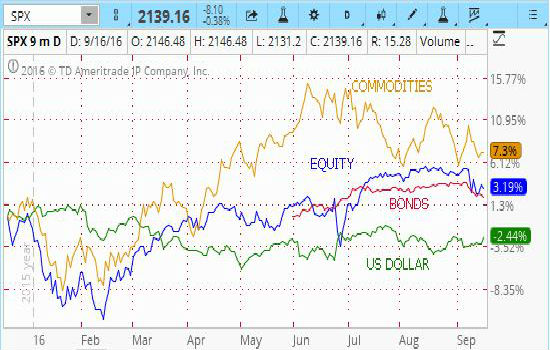Basics.
A good topic to develop in two or three posts, briefly and colloquially, as I always try to do, is the 'InterMarkets Analysis'. How it works, its importance, and the relationship among its instruments (stocks-bonds-currency-commodities), and how to take advantage of it for our trades, now that we are near another decision of the US Federal Reserve (FED) in November.
The Central Bank of each country (the FED in USA) control the interest rate, which has a direct impact on the value of the local currency. If they raise the interest rate, their currency tends to strengthen as investors look for high returns in their country for their short-term investments. If a government lowers the rate, it weakens its currency, since very few investors will be willing to lend their money to a country or its banks with a weak currency. Simple.
- A strong currency has a direct positive impact on stocks and bonds, since they pay more, but in turn generate inflation.
- The opposite occurs when the currency is weak: investors seek profitability in other regions and markets, and in commodities such as gold or oil, which rise in prices due to the increase in demand. In this environment, the yield of the bonds, which always accompanies the interest rate, falls and the price of bonds rises, due to the inverse relationship between the two. All these basic relations occur in an inflationary environment, in deflation some intermarket relations become inverse.
 |
Include the main four instruments of investments (commodities, stocks, bonds, and currency) in a single time chart is the best way to understand the InterMarket Analysis. |
How Central Banks work
I think the best way to explain it is with a real example: the Real Estate crisis of 2007 in the US. That time, during the crisis, the FED initiated a policy of economic stimulus, gradually lowering the interest rate to zero levels in order to 'warm the economy', and at the same time issuing currency to buy assets from banks (bonds issued by them) and generate liquidity in the market for low rate loans (this is called Quantitative Easing or QE). This generated the slow recovery of the economy and markets, and a progressive increase in the prices of commodities and services (i.e inflation), which today must be controlled because in the short term it generates unemployment. That was the discussion (it's eternal) in the FED, which is the 'least bad' decision that must be taken: either keep invariable the i-rate for a while to take care jobs at the cost of a little inflation (dovish point of view), or on the contrary, prevent the rise in inflation, raising the interest rate above it, at the cost of some unemployment and stable prices (the hawkish).
As an important document for later analysis, here is the FED Funds Rate History since 1970, and its relationship with the Gross Domestic Product (GDP or PBI in Spanish, publish quarterly) and Unemployment Data, issue the first day of every month.
Good Trading!
@BravoTrader
{fullWidth}

